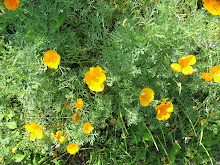 Native to Europe and western Asia, bindweed is thought to have made its way to the US as early as the 1700s as a seed contaminant. Highly adaptable and proficient in finding light, bindweed will aggressively rob other plants of soil nutrients and space to grow. According a link I found about how to control it, bindweed is often referred to as wild morning glory or creeping jenny, and it is so widespread that there are words for bindweed in 29 different languages. Although I was short on time yesterday, I managed to take a few photos, including the one above of a few plants in the plot that was next to the one that four of us (including the plot-holder) dug up.
Native to Europe and western Asia, bindweed is thought to have made its way to the US as early as the 1700s as a seed contaminant. Highly adaptable and proficient in finding light, bindweed will aggressively rob other plants of soil nutrients and space to grow. According a link I found about how to control it, bindweed is often referred to as wild morning glory or creeping jenny, and it is so widespread that there are words for bindweed in 29 different languages. Although I was short on time yesterday, I managed to take a few photos, including the one above of a few plants in the plot that was next to the one that four of us (including the plot-holder) dug up. What we tried our best to do was dig around the bindweed and pull it up, roots and all. Yet sometimes, despite our best efforts, we'd feel the snap of the plant breaking apart, and we'd have to dig further. We were doing that anyway, since the goal was to extract every possible piece of root, from the thick white arteries that you can see in the bag, to the smaller thread-like offshoots. We also pulled some of the bindweed from neighboring plots, though the infestation had not yet risen to the same point of severity. In any case, the gardener in the above plot, who will have to start over, and his neighbors will have to remain extra vigilant, checking for new growth weekly for the rest of the season.
What we tried our best to do was dig around the bindweed and pull it up, roots and all. Yet sometimes, despite our best efforts, we'd feel the snap of the plant breaking apart, and we'd have to dig further. We were doing that anyway, since the goal was to extract every possible piece of root, from the thick white arteries that you can see in the bag, to the smaller thread-like offshoots. We also pulled some of the bindweed from neighboring plots, though the infestation had not yet risen to the same point of severity. In any case, the gardener in the above plot, who will have to start over, and his neighbors will have to remain extra vigilant, checking for new growth weekly for the rest of the season. What was the origin of the MSG infestation of bindweed? Could it have arrived with a load of free compost, or with some strawberries that were transplanted from an outside garden? Regarding the latter, if you look around the MSG you will find many strawberry patches, often the result of plants spreading in from neighboring plots. Some gardeners like myself had kept them as an experiment, and after a successful harvest considered them a mainstay.
What was the origin of the MSG infestation of bindweed? Could it have arrived with a load of free compost, or with some strawberries that were transplanted from an outside garden? Regarding the latter, if you look around the MSG you will find many strawberry patches, often the result of plants spreading in from neighboring plots. Some gardeners like myself had kept them as an experiment, and after a successful harvest considered them a mainstay.This plot holder also had a strawberry patch, yet despite the possible risks of more bindweed, he has decided that in addition to tomatoes, he will keep growing strawberries. They seem to do well here, as opposed to in my backyard, where they had been eaten so often by some critters that I had to give up on growing them there, so I really can't blame him.
So, in the end, enough about the plants we don't want. With tulips in bloom everywhere, let me end this post on a brighter note.



3 comments:
That bindweed will keep you busy. We have a bit growing at the edge of our property. I hope my weed wacking & vinegar/salt solution keeps it there.
Do you have your broccoli planted out?
Good question! That has been on my mind lately. The new growth on my broccoli plants has gotten delicate and spindly. My next research task is to look into it and ask around about it, as well as find out if it's ready to go out.
I started hardening off the broccoli during the first week of April and then planted them out the last week of April. The last week of April is the earliest I can plant them out.
Post a Comment